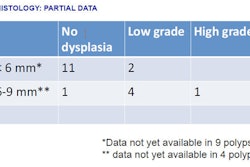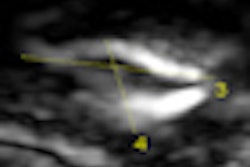CHICAGO - Technologists attending RSNA 2009: If you want to evaluate your hand-eye coordination, as well as your technical savvy, check out scientific poster LL-PD4245-B09 at McCormick Place's Lakeside Learning Center. A computer will assess your ability to identify the optimum inspiration time to take a chest x-ray of a howling infant.
The RSNA meeting's conversion this year of displaying all scientific posters, along with many educational exhibits, in digital format offers the potential for authors not only to convey facts, graphs, and photos, but also to incorporate some interactive functionality. Onsite digital displays offer huge potential to inform and educate a reader in ways that even the best developed paper poster cannot.
A typical description of the use of a computer-based video assessment tool designed to train radiologic technologists on identifying the moment of maximum aspiration of an infant when taking a chest x-ray, from the Medical Mission Hospital Wurzburg in Germany, has been transformed into an engaging opportunity to test one's own skills.
One could even fantasize that the library-silence in the darkened space of Lakeside's Digital Learning Zone, with rows of computer terminals displacing what would have been paper poster displays, could be broken by the cheers of teams of technologists assessing self and peer performance.
That's what the video tool being described is intended to do. It displays brief video clips of infants shown sleeping, being awake but calm, and crying their lungs out while positioned on an exam table for a chest radiograph. For each, the moment of deepest inspiration was determined based on single frame view analysis of the video.
In the training exercise, technologists watching the repetitive video clip mouse click when they identify the optimum image acquisition moment, doing this for a series of 10 times. The computer immediately analyzes and displays how accurate by seconds the decision was, and then provides a cumulative analysis at the conclusion of the 10 attempts. Each practice session is designed to take 40 minutes.
Dr. Heinz-Jakob Langen and colleagues report that the technologists benefit from interacting with the crying infant video clip, improving their performance the most after five consecutive minutes of use. Performance did not improve with the sleeping and at-rest child. The authors present performance statistics for six radiologic technologists of unspecified experience levels after having sessions with the training tool.
Copyright © 2009 AuntMinnie.com



















